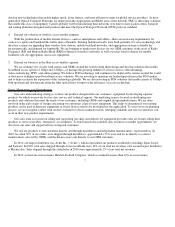Adaptec 2010 Annual Report Download - page 17
Download and view the complete annual report
Please find page 17 of the 2010 Adaptec annual report below. You can navigate through the pages in the report by either clicking on the pages listed below, or by using the keyword search tool below to find specific information within the annual report.
The final determination of our income tax liability may be materially different from our income tax provision.
We are subject to income taxes in both the United States and international jurisdictions. Significant judgment is required in
determining our worldwide provision for income taxes. In the ordinary course of our business, there are many transactions where the
ultimate tax determination is uncertain. Additionally, our calculations of income taxes are based on our interpretations of applicable
tax laws in the jurisdictions in which we file. Although we believe our tax estimates are reasonable, there is no assurance that the final
determination of our income tax liability will not be materially different than what is reflected in our income tax provisions and
accruals. Should additional taxes be assessed as a result of new legislation, an audit or litigation, if our effective tax rate should
change as a result of changes in federal, international or state and local tax laws, or if we were to change the locations where we
operate, there could be a material effect on our income tax provision and results of operations in the period or periods in which that
determination is made, and potentially to future periods as well. During the second quarter of 2008, one of our foreign subsidiaries
settled several ongoing tax matters for less than had been accrued as part of its liability for unrecognized tax benefits, resulting in the
recognition of tax benefits of $124.1 million. As a result of this settlement, we agreed to pay $18.0 million in cash and utilize $31.6
million in investment tax credits.
The ultimate resolution of outstanding tax matters could be for amounts in excess of our reserves established. Such events could
have a material adverse effect on our liquidity or cash flows in the quarter in which an adjustment is recorded or the tax payment is
due.
If foreign exchange rates fluctuate significantly, our profitability may decline.
We are exposed to foreign currency rate fluctuations because a significant part of our development, test, and selling and
administrative costs are incurred in foreign currencies. The U.S. dollar has fluctuated significantly compared to other foreign
currencies and this trend may continue. To protect against reductions in value and the volatility of future cash flows caused by
changes in foreign exchange rates, we enter into foreign currency forward contracts. The contracts reduce, but do not eliminate, the
impact of foreign currency exchange rate movements. In addition, this foreign currency risk management policy may not be effective
in addressing long-term fluctuations since our contracts do not extend beyond a 12-month maturity.
We regularly limit our exposure to foreign exchange rate fluctuations from our foreign net asset or liability positions. We
recorded a net $1.8 million foreign exchange loss on the revaluation of our income tax liability, net of deferred tax assets, in 2010
because of the fluctuations in the U.S. dollar against certain foreign currencies. A five percent shift in the foreign exchange rates
between the U.S. and Canadian dollar would cause an approximately $3.0 million impact to our pre-tax net income.
We are exposed to the credit risk of some of our customers.
Many of our customers employ contract manufacturers to produce their products and manage their inventories. Many of these
contract manufacturers represent greater credit risk than our OEM customers, who do not guarantee our credit receivables related to
their contract manufacturers.
In addition, a significant portion of our sales flow through our distribution channel, this generally represents a higher credit risk.
Should these companies encounter financial difficulties, our revenues could decrease, and collection of our significant accounts
receivables with these companies or other customers could be jeopardized.
Our business strategy contemplates acquisition of other products, technologies or businesses, which could adversely affect our
operating performance.
Acquiring products, intellectual property, technologies and businesses from third parties is a core part of our business strategy.
That strategy depends on the availability of suitable acquisition candidates at reasonable prices
16
























